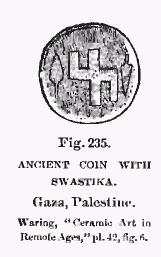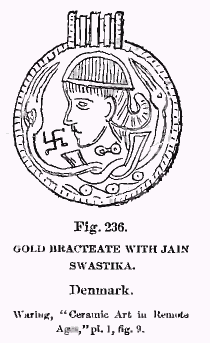

The Swastika
Dispersion of the Swastika
Swastika on coins in Mesembria and Gaza. --- Mr. Perey Gardner, in his article, "Ares as a Sun-god," (1) finds the Swastika on a coin of Mesembria in
 Thrace.
He explains that "mesembria is simply the Greek word for noon, midday
(meshmbria)." The coins of this
city bear the inscription MES
Thrace.
He explains that "mesembria is simply the Greek word for noon, midday
(meshmbria)." The coins of this
city bear the inscription MES Swastika on Danish gold bracteates. --- Fig. 236 represents a Danish gold bracteate with a portrait head, two serpents, and a Swastika with the outer ends finished with a curve or flourish similar to that of the Jains (fig. 33).
There are other bracteates with the Swastika mark, which belong to the
 Scandinavian
countries. (4) Some of them
bear signs referring to Christian civilization, such as raising hands
in prayer; and from a determination of the dates afforded by the coins
and other objects the Swastika can be identified as having continued into
the Christian era.
Scandinavian
countries. (4) Some of them
bear signs referring to Christian civilization, such as raising hands
in prayer; and from a determination of the dates afforded by the coins
and other objects the Swastika can be identified as having continued into
the Christian era. The coinage of the ancient world is not a prolific field for the discovery of the Swastika. Other specimens may be found than those here given. This search is not intended to be exhaustive. Their negative information is however, valuable. It shows, first, that some of the early stamps or designs on coins which have been claimed as Swastikas were naught but the usual punch marks; second, it shows a limited use of the Swastika on the coinage and that it came to an end in very early times. Numismatics afford great aid to archæology form the facility and certainty with which it fixes dates. Using the dates furnished by the coinage of antiquity, it is gravely to be questioned whether the prolific use of the Swastika in Asia Minor (of which we have such notable examples on specimens of pottery from the hill of Hissarlik, in Greece) did not terminate before coinage began, or before 480 B. C., when the period of finer engraving began, and it became the custom to employ on coins the figures of gods, or tutelary deities, and of sacred animals. Thus the use of the Swastika became relegated to objects of commoner use, or those having greater relation to superstition and folklore wherein the possible value of the Swastika as an amulet or sign with power to bring good luck could be better employed; or, as suggested by Mr. Greg, that the great gods which, according to him, had the Swastika for a symbol, fell into disrepute and it became changed to represent something else.
Pre-Columbian Times.
A shell ornament, on the convex surface of which a very curious ornamental
 design
has been engraved. The design, enclosed by a circle, represents a cross
such as would be formed by two rectangular tablets or slips slit longitudinally
and interlaced at right angles to each other. The lines are neatly and
deeply incised. The edge of the ornament has been broken away nearly all
around.
design
has been engraved. The design, enclosed by a circle, represents a cross
such as would be formed by two rectangular tablets or slips slit longitudinally
and interlaced at right angles to each other. The lines are neatly and
deeply incised. The edge of the ornament has been broken away nearly all
around.The incised lines of this design (fig. 237) represent the Swastika turned to the left (though the description does not recognize it as such). It has small circles with dots in the center, a style of work that may become of peculiar value on further investigation, but not to be confounded with the dots or points in what M. Zmigrodzki calls the Croix swasticale. The mound from which this specimen came, and the objects associated with it, show its antiquity and its manufacture by the aborigines untainted by contact with the whites. The mound is on the
ENDNOTES:
1. "Numismatic Chron.," pt. I, 1880. See p. 788 of this paper. [Back]
2. Archæologia, XVIII, pt. II, 1885, p. 306. Back
3. Athenæum, August 20, 1892. Back
4. "Viking Age," II, figs. 1307, 1309. Back
5. Page 436, fig. 140. Back
<< Previous Page Next Page >>
© 2004-2007 Northvegr.
Most of the material on this site is in the public domain. However, many people have worked very hard to bring these texts to you so if you do use the work, we would appreciate it if you could give credit to both the Northvegr site and to the individuals who worked to bring you these texts. A small number of texts are copyrighted and cannot be used without the author's permission. Any text that is copyrighted will have a clear notation of such on the main index page for that text. Inquiries can be sent to info@northvegr.org. Northvegr™ and the Northvegr symbol are trademarks and service marks of the Northvegr Foundation.

|